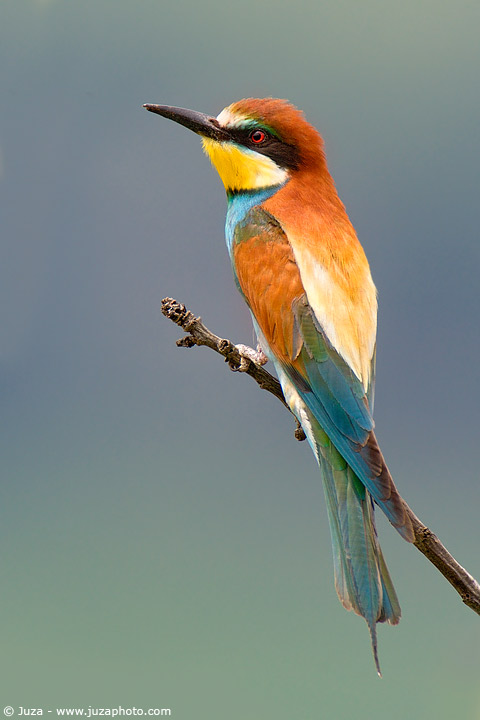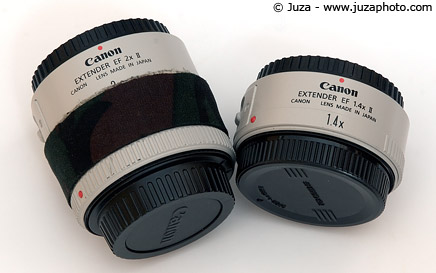Canon 2.0x II and Canon 1.4x II teleconverters (my 2x has a LensCoat camouflaging). The teleconvertes are essential tools in wildlife photography - I have both the Canon 1.4x TC II and the Canon 2.0x TC II and I use them a lot. A teleconverter is a lens that magnifies the center portion of the image, increasing the reach of the main lens by 1.4x or 2x. For example, a 600mm with 1.4x becomes a 840mm (600x1.4), and a 600mm with 2x becomes a 1200mm (600x2).
Of course, the teleconverters have they pros and cons, and you need to understand them to get good results. With TCs you gain focal lenght, but you have three disadvantages: loss of light, reduced sharpness and slow or no AF.
The loss of light depens by the TC: with 1.4x TC you lose 1 stop, while with 2x you lose two stops. For example, the 600 f4 with 1.4x is no longer f/4, it becomes a 840mm f/5.6; with the 2x it is a 1200 f/8. If you are photographing in low light, the darker apertures increases the risk of blur, since a darker aperture gives a slower shutter speed than the native aperture of the lens.
The loss of sharpness in another cons of the TCs. With the 1.4x usually there is not an huge loss, while with the 2x TC the image quality drops unless you use it on a razor sharp lens. Remember that the TC magnifies every defect of your lens - if the lens is already a bit soft, with a TC it becomes even softer - sometimes the image quality drops so much that the lens becomes unusable. I recommend to use the TCs only on the best primes, as the big superteles. With the 600 f4 and the 1.4x the loss of sharpness is truly negligible (actually, it is nearly impossible to tell if a photo has been taken at 600mm or 840mm unless you look in the exif). With the 2x, instead, the is a noticeable softening even with the 600 f/4, even though the image quality is still acceptable at f/8 (wide open) and it is pretty good at f/11 (stopped down by one stop).
It is very important to understand the limits of your lens: sometimes adding a TC does not increase at all the detail...actually, sometimes you get more detail by cropping and enlarging a photo taken with the bare lens than using a TC. As previously said, the TC magnifies the image, but it reduces the sharpness. If the amount of detail that you gain with the increased mangnification is higher than the detail that you lose due to the reduced sharpness, the TC is truly useful. If, instead, you lose more detail due to the softening than what you gain with added magnification, the TC is detrimental.
For example, a 2x TC is truly useful on a 300 f/2.8 or a 600 f/4. The same TC, mounted on a cheap 70-300 f/5.6, is detrimental: you get an unusable 140-600 f/11 with crappy image quality and no AF. The detail is worse than the bare lens, since you have magnified an already soft image, and you have made it even softer due to the TC.
Other than the main lens, there are two other factors that influence the image quality: the optics of the TC and the pixel size of the camera. Whenever possible, I recommend to buy the original Canon TCs instead of third-brand TCs; usually the image quality of the Canons is better. The pixel size of the camera is the third factor that influences the results of TCs. A camera that has very small photosites (e.g. the Nikon D2Xs or the Canon EOS 400D) has much higher optical requirements than a camera with large photosites (as the Canon EOS 5D or the Nikon D2Hs). In other words, if you mount, lets say, a 300 2.8 + 2x on the 400D you will notice much more softening than the same lens and TC combo on the 5D, since the 400D has smaller photosites (pixels) thus you need higher resolving power.
The third disadvantage of TCs regards the AF operation. If the lens becomes darker than f/5.6, the AF is disabled on every camera except 1 series: for example, if you mount a 1.4x TC on the 70-200 f/4 the lens becomes a 105-280 f/5.6 and AF works on every camera, but if you mount the 2x TC on the 70-200 f4 the AF is disabled (unless you have a 1 series) because the lens has become a 140-400 f/8. With the 1 series the limit is f/8, so you can use AF even with a f4 lens + 2x or with a f/5.6 + 1.4x. When I've taken the bee-eater photo I had the Canon 350D so I had to use manual focus; I stopped down to f/11 to get the best sharpness.
In any case, even if the AF works it becomes slower: with the 1.4x the AF is 25% slower, and with the 2x it is 50% slower. This due to the reduced brightness of the lens and to the AF operation...when the camera detects a (Canon) TCs, it slows down the AF to ensure a precise focussing.
The teleconverters are great tools, but they don't do magic: I highly recommend to get both the 1.4x and 2.0x TCs if you have a supertele (from 300 2.8 to 600 f4); I recommend to get the 1.4x if you have a professional telezoom or good tele (e.g. 70-200 L, 400 f/4, 400 f/5.6); I recommend to avoid TCs with any other lens.
Risposte e commenti
Che cosa ne pensi di questo articolo?
Vuoi dire la tua, fare domande all'autore o semplicemente fare i complimenti per un articolo che ti ha colpito particolarmente? Per partecipare iscriviti a JuzaPhoto, è semplice e gratuito!
Non solo: iscrivendoti potrai creare una tua pagina personale, pubblicare foto, ricevere commenti, partecipare alle discussioni e sfruttare tutte le funzionalità di JuzaPhoto. Con oltre 241000 iscritti, c'è spazio per tutti, dal principiante al professionista.



 JuzaPhoto contiene link affiliati Amazon ed Ebay e riceve una commissione in caso di acquisto attraverso link affiliati.
JuzaPhoto contiene link affiliati Amazon ed Ebay e riceve una commissione in caso di acquisto attraverso link affiliati.